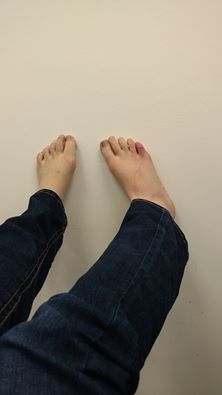There are many different types of Connective Tissue Disorders (CTDs) with symptoms that are all very similar. One thing that holds true among all the CTDs, however, is that they are genetic/heritable (at least the ones I am discussing here). The two most common type in which genetic diseases are inherited are: autosomal dominant and autosomal recessive.
To understand what these mean, you have to first understand the genetics behind the disease. Most everything in our body is a product of our “genes”. A gene is a section of DNA that contains the blueprint for specific proteins. Everyone has two copies of a gene: One from their mother and one from their father. When a person inherits a genetic disorder, it means that either one or both copies of a specific gene is “damaged” ie. mutated.
With autosomal recessive disorders (like some rare types of Ehlers Danlos syndrome) you need both genes to be mutated in order to have the disorder, ie. you need to inherit a bad copy from both your mother and your father. If you only have one mutated gene, then you are a “carrier” without symptoms of the disorder. You can only have an autosomal recessive disorder if you have two mutations and you cannot pass the disorder to your children (although they would have 50% chance of being a carrier).
With autosomal dominant disorders (like most types of CTDs including the more common types of EDS, Marfan, Loeys-Dietz Syndrome…etc) you only need to have one gene mutated in order to have the disorder, ie. you can inherit a bad disorder-causing gene from either your father or your mother. This means that your mother or father would also have the disorder and that you have 50% chance of passing on the disorder.
Very rarely, someone can present with a new mutation and will not have a family history of the mutation. This occurs more frequently in some connective tissue disorders compared to others.
Here is a list of the more common CTDs and their associated genes (click on the disorder to be redirected to a more detailed explanation of the disorder and its symptoms):
Ehlers-Danlos Syndrome, Hypermobility Type – No known genes (Autosomal Dominant)
Ehlers-Danlos Syndrome, Classic Type – Col5a1 & Col5a2 (Autosomal Dominant)
Ehlers-Danlos Syndrome, Vascular Type – Col3a1 (Autosomal Dominant)
Ehlers-Danlos Syndrome, Kyphoscoliotic Type – PLOD1 (Autosomal Recessive)
Marfan Syndrome – FBN1 (Autosomal Dominant)
Loeys-Dietz Syndrome (Types 1-5) – TGFBR1, TGFBR2, SMAD3, TGFB2 & TGFB3 (Autosomal Dominant)
Shprintzen-Goldberg syndrome – SKI (Autosomal Dominant)
Homocystinuria – CBS (Autosomal Recessive)
Stickler Syndrome – Col2a1, Col11a1, Col11a2, Col9a1, Col9a2, & Col9a3 (Autosomal Dominant or Autosomal Recessive – depending on the affected gene)
*This post is written by a PhD Student with a background in genetics.
**This post does not contain all methods of inheritance and is an abridged list of connective tissue disorders.



